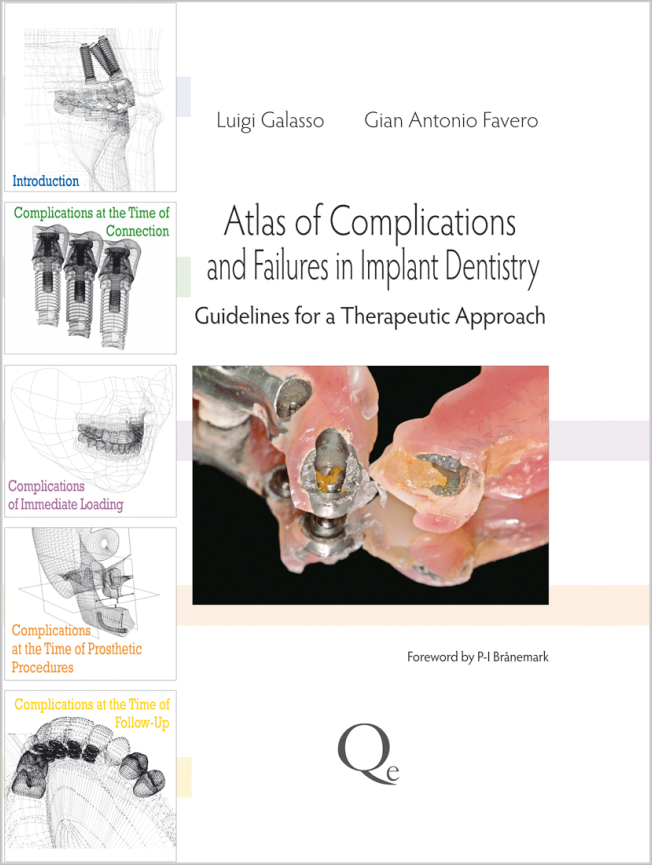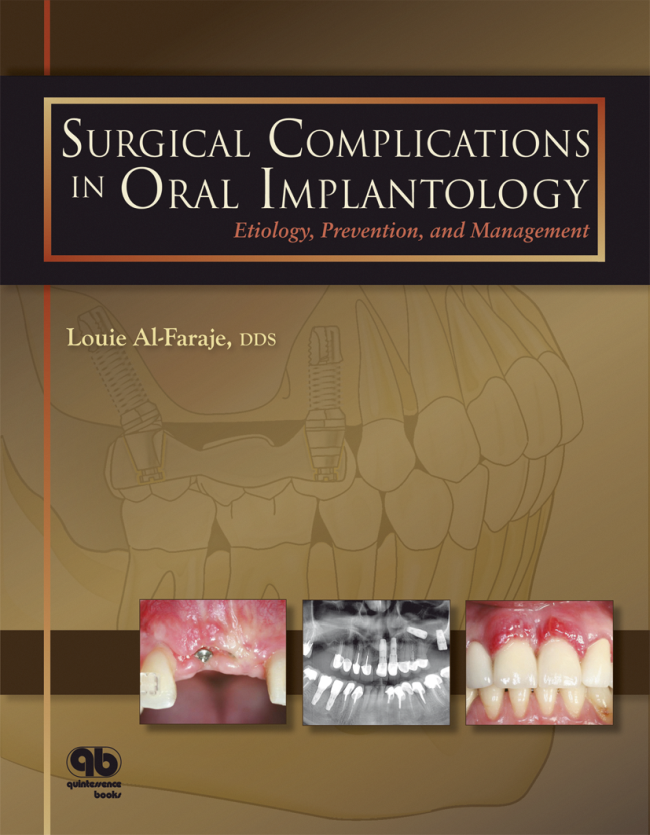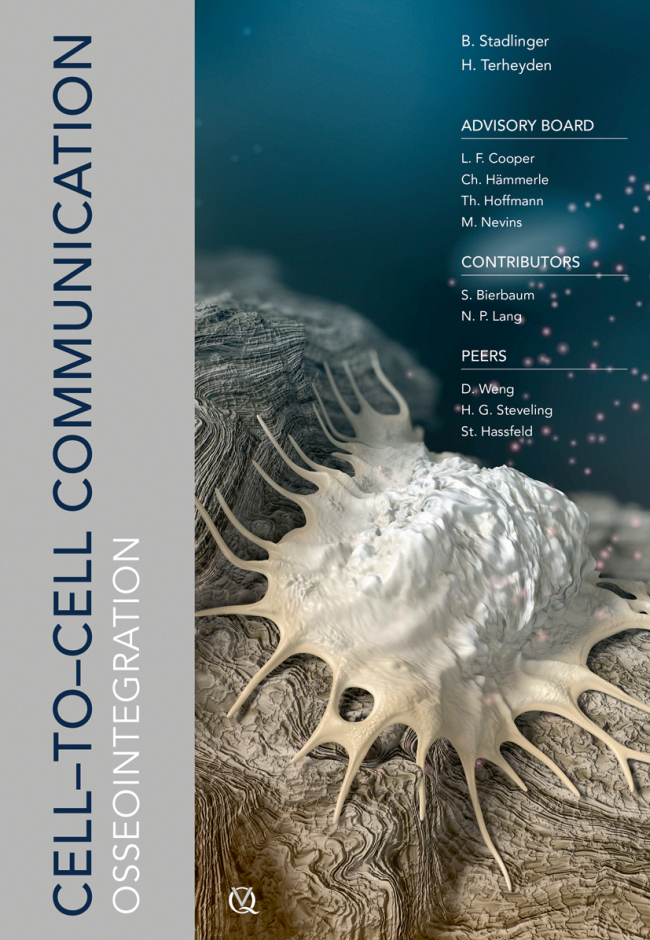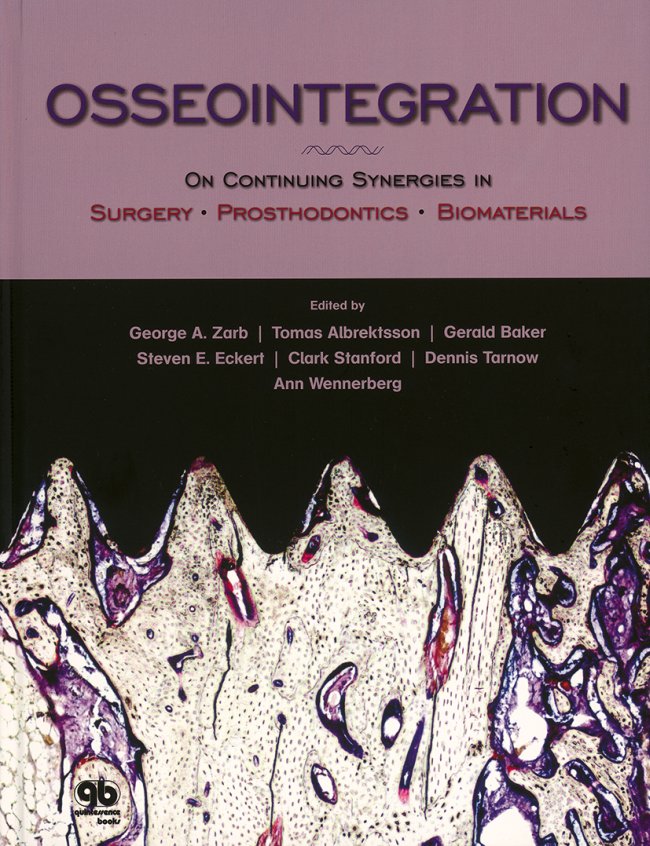Luigi Galasso / Gian Antonio Favero
Atlas of Complications and Failures in Implant Dentistry
Guidelines for a Therapeutic Approach
1st Edition 2013
Buch
Hardcover, 344 Seiten, 780 Abbildungen
Sprache: Englisch
Kategorie: Implantologie
Artikelnr.: BI022
ISBN 978-88-7492-182-9
QP Italy
After nearly three decades of widespread application, implant-prosthetic therapy has been proved to be effective and safe. However, in implant treatment modalities, as in any complex therapeutic approach, complications inevitably arise in a certain percentage of cases. The authors of this clinical atlas aim to both reduce the clinical incidence of avoidable errors and provide clinicians with tested management protocols to follow when complications arise. In separate chapters, the book presents complications that can develop at different stages of treatment: implant connection, immediate loading, prosthetic phase, and follow-up. The first part of each chapter describes specific complications in terms of their etiology, clinical signs and symptoms, diagnosis, and resolution and treatment. Then, using clinical case examples, the authors relate the stories of how these complications have occurred in real-life clinical situations and show how variables such as individual patient concerns, desires, and priorities affect the way in which they are handled. This practical reference book serves as a guide for diagnosis and treatment of complications and also, more importantly, provides a code of conduct and a philosophy for how to approach complications.
Contents
Chapter 1. Introduction
• Historical Background of Prosthetic Complications • Nature and Function of the Early • Implant Treatment Approach: • The Toronto Bridge • Resorption of Edentulous Ridges • Function • Esthetics • Specifics of the Various Dental Implant Systems • Biomechanics • Dental Prosthetic Techniques and Technology • Role of the Patient • Significance and Classification of Complications • Classification
Chapter 2. Complications at the Time of Connection
• Malpositioning of Implants • Damage to Internal Implant Threads or Implant Connection • Ingestion or Inhalation of Instruments • Clinical Cases: Esthetic Failure, Malpositioning of Implants and Premature Loss of Implants, Malpositioning of the Implant
Chapter 3. Complications of Immediate Loading
• Premature Implant Loss • Clinical Cases: Premature Implant Loss, Implant Loss During the Healing Period, Submental Cutaneous Fistula, Failure to Deliver an Immediate Prosthesis
Chapter 4. Complications at the Time of Prosthetic Procedures
• Malpositioning of Implants • Technical Problems • Damage to the Abutment-Screw Threads • Ingestion or Inhalation of Instruments • Cementation Problems • Clinical Cases: Mobility of the Prosthesis and Interference with Adjacent Structures, Interference with Adjacent Structures, Implant Proximity, and Esthetic Shortcomings, Interference with Adjacent Structures, Functional Limitations, Esthetic Shortcomings, and Framework Fracture, Invasion of the Mandibular Canal and Failure to Load Implants, Interference with Adjacent Structures
Chapter 5. Complications at the Time of Follow-Up
• Mobility of the Prosthesis • Acute and Chronic Inflammation • Fractures • Esthetics • Craniomandibular and Occlusal Disorders • Phonetic Disorders • Biting of Tongue and Cheeks • General Adaptation Problems • Proximity of Implants to Adjacent Anatomical Structures • Delayed Loss of Implants • Clinical Cases: Acute and Chronic Inflammation, Acute and Chronic Inflammation, Acute and Chronic Inflammation, Fracture of the Prosthesis, Fracture of the Prosthesis and Delayed Loss of Implants, Acute and Chronic Inflammation, Repeated Fracture of Prosthetic Screws, Mobility of the Prosthesis and Interference with Adjacent Structures, Fracture of the Prosthesis, Acute and Chronic Infection, Acute and Chronic Infection, Fracture of the Retainer in an Overdenture Ball-Attachment System
Contents
Chapter 1. Introduction
• Historical Background of Prosthetic Complications • Nature and Function of the Early • Implant Treatment Approach: • The Toronto Bridge • Resorption of Edentulous Ridges • Function • Esthetics • Specifics of the Various Dental Implant Systems • Biomechanics • Dental Prosthetic Techniques and Technology • Role of the Patient • Significance and Classification of Complications • Classification
Chapter 2. Complications at the Time of Connection
• Malpositioning of Implants • Damage to Internal Implant Threads or Implant Connection • Ingestion or Inhalation of Instruments • Clinical Cases: Esthetic Failure, Malpositioning of Implants and Premature Loss of Implants, Malpositioning of the Implant
Chapter 3. Complications of Immediate Loading
• Premature Implant Loss • Clinical Cases: Premature Implant Loss, Implant Loss During the Healing Period, Submental Cutaneous Fistula, Failure to Deliver an Immediate Prosthesis
Chapter 4. Complications at the Time of Prosthetic Procedures
• Malpositioning of Implants • Technical Problems • Damage to the Abutment-Screw Threads • Ingestion or Inhalation of Instruments • Cementation Problems • Clinical Cases: Mobility of the Prosthesis and Interference with Adjacent Structures, Interference with Adjacent Structures, Implant Proximity, and Esthetic Shortcomings, Interference with Adjacent Structures, Functional Limitations, Esthetic Shortcomings, and Framework Fracture, Invasion of the Mandibular Canal and Failure to Load Implants, Interference with Adjacent Structures
Chapter 5. Complications at the Time of Follow-Up
• Mobility of the Prosthesis • Acute and Chronic Inflammation • Fractures • Esthetics • Craniomandibular and Occlusal Disorders • Phonetic Disorders • Biting of Tongue and Cheeks • General Adaptation Problems • Proximity of Implants to Adjacent Anatomical Structures • Delayed Loss of Implants • Clinical Cases: Acute and Chronic Inflammation, Acute and Chronic Inflammation, Acute and Chronic Inflammation, Fracture of the Prosthesis, Fracture of the Prosthesis and Delayed Loss of Implants, Acute and Chronic Inflammation, Repeated Fracture of Prosthetic Screws, Mobility of the Prosthesis and Interference with Adjacent Structures, Fracture of the Prosthesis, Acute and Chronic Infection, Acute and Chronic Infection, Fracture of the Retainer in an Overdenture Ball-Attachment System

Autor
Luigi Galasso

Autor








